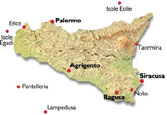 |
 |
|
Trapani | ||
|
||||||||
|
Less ancient than most large cities in Sicily - it became important only from 260 BC. Previously it was merely seen as the harbour of Eryx (Erice). The name comes from the Greek drepanon, meaning a sickle - and in this is thus similar to Zancle, the original name of Messina, and for the same reason: both cities at opposite ends of the island have sickle-shaped promontories protecting a natural harbour. Trapani actually has two harbours, one on either side - one of the reasons that made it seem an obvious location for Homer's city of the Phaeacians on the island of Scherie.
In fact ever since Samuel Butler's The Authoress of the Odyssey conjured up the delightful concept of the Odyssey being written by a woman - who inserted herself into the narrative as the charming Nausicaa - the Trapanesi have been extremely keen to equate their city with Alcinous's. They even have an appropriately shaped rock in the harbour to represent the Phaeacian vessel that turned to stone after delivering Odysseus back to Ithaca. There is quite an academic industry supporting this view - you'll find a section of books arguing the case in any good bookshop in Trapani (and there are several such!). Trapani for me is two cities: the centro storico by the port with its narrow streets, great fish restaurants (couscous is the local speciality - we are anly 50 miles from Tunisia), fashionable shops (good as Taormina), and lively atmosphere (not unlike Sciacca); and the new town with its incomprehensible one-way systems, and hideous architecture. It's easy getting through the new to reach the old - getting out again (in my experience) takes time and some luck! I stayed in a palace right in the centre (Palazzo Berrario Ferro XVIII sec) - a rather run down one, and actually the cheapest place I found in Sicily at £15,000 a night (about £12 sterling at 1993 rates). But I still enjoyed the grand facade and courtyard, and the marble steps to the piano nobile. My room was definitely on the homely side, though, and there was no lock on the door, and the toothless bald partron in his cosijamas charged extra for the rudimentary shower. I ate well, if expensively, at the Trattoria del Porto: antipasto di mare followed by cuscus con pesce followed by salsiccie and loads of chips (unusual in Sicily) - all accompanied by Benny Hill at full volume on the TV! During the post-prandial passeggiata I discovered that the Trapanesi go in for surreal graffiti: two examples "LA MAFIA N' ESISTE (sic) PAS - CICERO DE DOMO SUA" [Why in French?] "TRAPANESE E FIGLIO DI TROIA" [When graffiti writers have read Virgil and Samuel Butler, you know you are in a centre of culture - they obviously only watch Benny Hill for the joy of ironic postmodern deconstruction.] I left the Palazzo early (7 am) after my second night - I was impressed to find a bar not only open for caffè e cornetto (my usual breakfast on tour), but the patron and his son already wearing crisp uniforms to match their decor (pink jackets with green piping, pink ties, pink hats also greenly edged), while, as at Sciacca, I watched the sad and solitary Tunisian males carrying Standa bags heading off. In two visits I've not yet made it to the Museo Pepoli (perhaps because it's hidden in the new part of town) - but it's supposed to be well worth a visit. The shallow lagoons south of Trapani (like the one in which Motya sits) have been used for salt-production since ancient times. Traditionally windmills were used to pump out the water from the pans using the Archimedes screw: the trade is undergoing a revival thanks to the current fashion for sea-salt. There's a salt museum on the road to Motya.
From Trapani it's quite easy to visit the Egadi Islands (Aegates Insulae) - Favignana, Levanzo and Marettimo - which Samuel Butler believed was Homer's Ithaca. I've not yet been there.
|
 |
Use the table below to find your way around Sicily: |  |
||||||||||
| Map | Index | PA | ME | CT | EN | CL | SR | RG | AG | TP | ||
Printer friendly page: click to print
| What's new? | Search the site? | Main Index? | Bookshop? | Top of Page? | ||||
|
The Classics Pages are written and designed
by Comments, questions and contributions welcome. |
||||||||